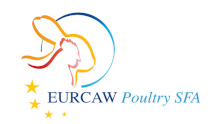Type de document : fiches techniques publiées sur le site de l’EURCAW-Poultry-SFA
Auteur : European Union Reference Centre for Animal Welfare for Poultry and other small farmed animals (EURCAW-Poultry-SFA)
Résumé en français (traduction) : Les indicateurs de bien-être portant sur les cinq domaines prioritaires du bien-être seront décrits ici. Pour chaque indicateur, une fiche d’information sera élaborée et décrira le problème de bien-être sous-jacent, les exigences légales et une méthode d’inspection et de notation suggérée. Lorsque des vétérinaires ou des inspecteurs officiels procèdent à des inspections du bien-être animal dans des exploitations agricoles ou des abattoirs, ils suivent une liste de contrôle liée aux exigences légales européennes et/ou nationales, souvent spécifiées pour l’espèce et le stade de production concernés. Au cours d’une telle inspection, différents paramètres sont choisis comme indicateurs du bien-être animal, et la somme de ces paramètres est considérée comme le statut général du bien-être du troupeau.
Définitions utiles :
– Indicateur : un événement, une observation, un enregistrement ou une mesure ayant un lien avéré avec l’exigence légale, qui peut être :
– Indicateur basé sur l’animal (ABI) : une réponse d’un animal ou un effet sur un animal utilisé pour évaluer son bien-être. Il peut être pris directement sur l’animal ou indirectement et comprend l’utilisation de registres d’animaux.
– Indicateur basé sur les ressources (RBI) : évaluation d’une caractéristique de l’environnement dans lequel l’animal est détenu ou auquel il est exposé.
– Indicateur basé sur la gestion (MBI) : évaluation de ce que fait le responsable de l’unité animale ou le préposé aux stocks, et des processus ou outils de gestion utilisés.
– Indicateur iceberg : indicateur reflétant les principales questions de bien-être d’une manière intégrée afin de permettre une première vue d’ensemble de l’état de bien-être.
lien vers la fiche pour l’évaluation de l’état de conscience des poulets de chair (en français)
Résumé en anglais (original) : Welfare indicators addressing the five prioritized welfare areas will be described here. For an indicator, a factsheet will be developed and will describe the underlying welfare concern, the legal requirements, and a suggested inspection and scoring method.
When official veterinarians or inspectors perform animal welfare inspections on farms or at slaughterhouses, they follow a checklist tied to the EU and/or national legal requirements, often specified for the specific species and stage of production. During such an animal welfare inspection, different parameters are chosen as indicators of animal welfare, and the sum of those is considered the overall welfare status of the flock.
Useful definitions:
– Indicator: an occurrence, observation, record, or measurement which has a proven relationship with the legal requirement, which can be:
– Animal-based indicator (ABI): a response of an animal or an effect on an animal used to assess its welfare. It can be taken directly on the animal or indirectly and includes the use of animal records.
– Resource-based indicator (RBI): an evaluation of a feature of the environment in which the animal is kept or to which it is exposed.
– Management-based indicator (MBI): an evaluation of what the animal unit manager or stockperson does, and which management processes or tools are used.
– Iceberg indicator: indicator reflecting major welfare issues in an integrative manner in order to enable an initial overview of the welfare state.
link to indicator factsheet for assessing the state of consciousness in broilers
link to indicator factsheet for assessing the state of consciousness in turkeys
link to iceberg indicator factsheet for assessing Severe Feather Pecking
link to iceberg indicator factsheet for on farm assessment of Feather Cleanliness
link to iceberg indicator factsheet for assessing Foot Pad dermatitis (FPD) in Broiler Chicken
link to iceberg indicator factsheet for assessing foot lesions at slaughter in laying hens




